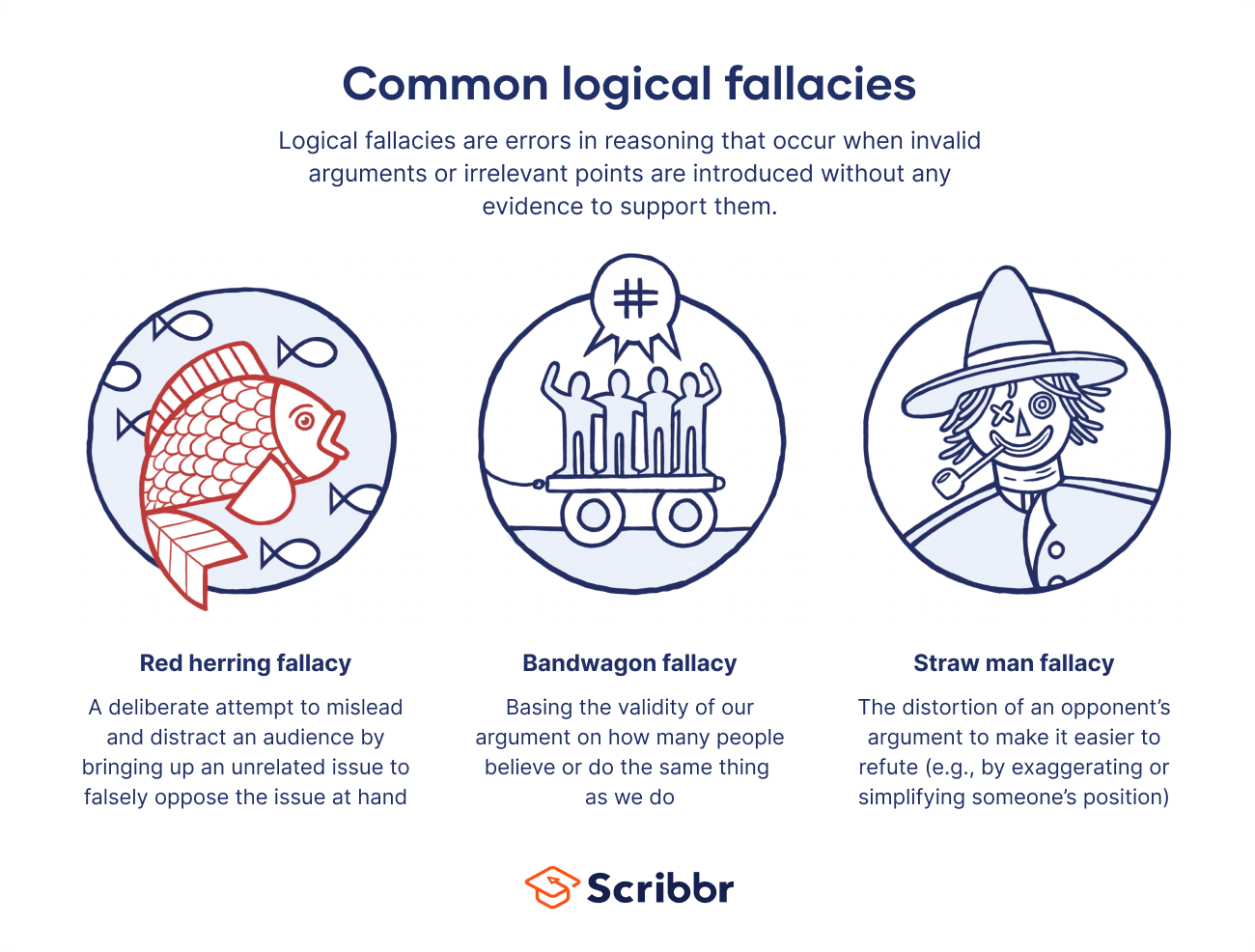Have you ever found yourself in an argument where you just couldn’t quite put your finger on why the other person’s reasoning felt off? Maybe they were making sweeping generalizations or appealing to emotion instead of logic. These are examples of fallacies, errors in reasoning that can undermine the validity of an argument. Understanding different types of fallacies is crucial for critical thinking and effective communication. It empowers you to identify weaknesses in arguments, both your own and those of others. This article will delve into the fascinating world of fallacies, equipping you with the tools to navigate complex arguments and make informed decisions.

Image: www.scribbr.com
I remember a time in college when I was debating a friend about the merits of a new policy. He claimed everyone supported it, citing a handful of his friends as evidence. I pointed out that his sample size was tiny and not representative of the whole student body. He quickly got defensive, but I was able to explain to him how his argument was flawed by using the fallacy of hasty generalization. This experience helped me realize the power of understanding fallacies. By knowing how to identify them, I could better evaluate evidence, challenge faulty logic, and engage in more productive conversations.
What are Fallacies?
Fallacies are flawed patterns of reasoning that can lead to invalid conclusions. They are often used to persuade or manipulate others, but they lack the logical rigor necessary for sound arguments. Think of them as cracks in the foundation of a building, weakening its structural integrity. They can be subtle or blatant, and they are prevalent in everyday conversation, media, and even academic discourse.
Fallacies are not necessarily lies or intentional deception. Sometimes, people may genuinely believe their faulty argument is true. Others might use fallacies unconsciously, simply because their thinking patterns have become ingrained over time. However, regardless of intention, fallacies can mislead and deceive, hindering our ability to make informed decisions and arrive at truth.
Common Types of Fallacies:
Formal Fallacies:
Formal fallacies are errors in the structure or form of an argument, violating the rules of logic. They can be identified simply by analyzing the relationship between premises and conclusions, regardless of the content of the argument. Here are a few examples:
- Affirming the consequent: “If it is raining, then the ground is wet. The ground is wet; therefore, it is raining.” Although the ground being wet often means it is raining, there could be other reasons for wet ground, such as a sprinkler system.
- Denying the antecedent: “If it is raining, then the ground is wet. It is not raining; therefore, the ground is not wet.” The weather could change quickly, and the ground could still be wet even if it isn’t raining presently.

Image: www.reddit.com
Informal Fallacies:
Informal fallacies are errors in the content of an argument, rather than its structure. They can be more challenging to spot because they often rely on emotional appeals, misleading connections, or misinterpretations of evidence. Some of the most common informal fallacies include:
- Ad hominem: Attacking the person making the argument instead of addressing their claims. “You’re just saying that because you’re a liberal.”
- Straw man: Misrepresenting the opponent’s argument to make it easier to attack. “You want to ban guns? That means you want criminals to have free reign!”
- False dilemma: Presenting only two options when there are actually more. “You’re either with us or against us.”
- Appeal to authority: Using the authority of a person or group as evidence to support a claim. “My doctor says this medicine works, so it must be true!”
- Appeal to emotion: Using emotional appeals to sway an audience instead of logical reasoning. “If you don’t vote for this candidate, our country will fall apart!”
- Hasty generalization: Drawing a broad conclusion from a small or unrepresentative sample. “I met two people from that city, and they were both rude. Everyone in that city must be rude.”
- Post hoc ergo propter hoc: Assuming that because one event occurred before another, the first event caused the second. “I started taking this new vitamin, and my cold went away quickly. It must be the vitamin that cured me!”
- Correlation/causation: Assuming that a correlation between two events implies that one event caused the other. “Ice cream sales rise in the summer, and so do crime rates. Therefore, eating ice cream must lead to crime!”
Fallacies In Online Discourse:
The internet, with its vast reach and anonymity, has become fertile ground for the proliferation of fallacies. The fast-paced, often confrontational nature of online discussions can lead to hasty conclusions, emotional outbursts, and a lack of rigorous critical analysis. Here are a few examples of how fallacies manifest in online discourse:
- Ad hominem attacks: Online platforms often see personal insults and attacks on character, especially when people disagree. This behavior diverts attention from the actual argument and can escalate into online harassment.
- Echo chambers: Social media algorithms can create echo chambers where users are only exposed to information that confirms their existing biases. This can lead to a distorted view of reality and make it harder to evaluate arguments objectively.
- Misinformation and fake news: The internet facilitates the spread of misinformation through unreliable sources and unverified claims. This can be exacerbated by fallacies such as appeal to authority (quoting a non-expert source as an authority) or hasty generalizations (drawing conclusions from a few anecdotal experiences).
Avoiding Fallacies:
Becoming aware of common fallacies is the first step towards avoiding them. Here are some tips for strengthening your critical thinking skills and avoiding common fallacies:
- Be mindful of your biases: Everyone has biases, and they can easily influence our reasoning. Be aware of your own biases and try to approach arguments with an open mind.
- Consider all sides: Don’t just focus on evidence that supports your own position. Seek out diverse perspectives and examine the arguments from all sides.
- Check your assumptions: Make sure your reasoning is based on facts and not just assumptions. Question your own assumptions and be open to changing your mind if new evidence emerges.
- Focus on evidence and logic: Don’t let emotional appeals sway your judgment. Instead, focus on the evidence and the logic of the argument.
- Challenge your own thinking: Don’t be afraid to question your own beliefs and arguments. This can help you identify any hidden fallacies in your own thinking.
Tips for Detecting Fallacies in Others:
Critical thinking applies not just to your own reasoning but also to evaluating arguments from others. When engaging in discussions, ask yourself:
- Is the argument attacking the person making it, or the argument itself?
- Are any claims backed up by factual evidence? How reliable is the source of that evidence?
- Are there any unstated assumptions being made?
- Is the argument appealing to your emotions instead of logic?
- Is there a clear connection between the premises and the conclusion?
Frequently Asked Questions (FAQs):
Q: Why is it important to identify fallacies?
A: Identifying fallacies is essential for critical thinking, informed decision-making, and effective communication. It helps us separate valid arguments from faulty ones, making us more discerning consumers of information.
Q: Are fallacies always intentional?
A: No, fallacies are not always intentional. Some people may unwittingly use fallacies because they haven’t been trained in critical thinking, or because their reasoning has become habituated over time.
Q: Can I use fallacies in my own arguments?
A: It’s not recommended to use fallacies in your arguments. Doing so can undermine your credibility and weaken your case, even if you believe the argument is true. Instead, focus on building well-supported arguments with evidence and logic.
Types Of Fallacies And Examples Pdf
Conclusion:
Learning about different types of fallacies is a vital step in becoming a skilled critical thinker. By recognizing these pitfalls in reasoning, we can better evaluate information, engage in productive dialogue, and avoid being misled by faulty arguments. So, keep your critical thinking muscles sharp, challenge faulty logic, and strive for clarity and accuracy in your own arguments. Remember, fallacies are not just theoretical concepts—they are prevalent in everyday communication and can have significant consequences. By being aware of these errors in reasoning, we can become more discerning consumers of information and contribute to a more informed and thoughtful society.
Are you interested in learning more about fallacies or have you encountered any interesting examples in your own life? Share your thoughts in the comments below.





